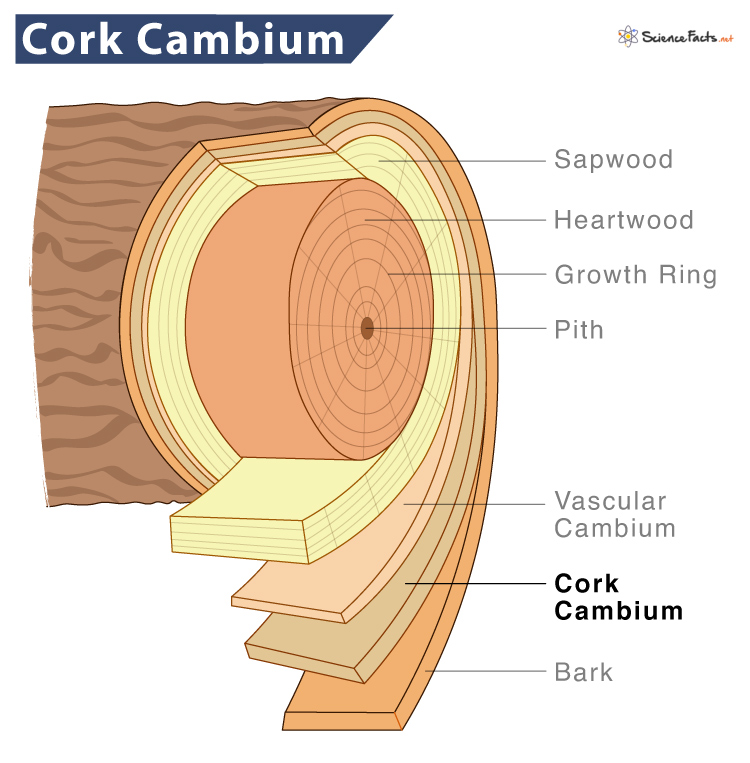Cork Cambium
The cork cambium or phellogen is a type of meristematic tissue found in many woody plants’ outer covering of the stem or trunk. It is thus one of the three parts of the thicker protective layer of the bark, called the periderm. The other two parts are cork (phellem) and phelloderm.
As the plant matures, the thin epidermal layer (epidermis) is replaced by the periderm. The cork cambium in the periderm helps plants to form new cells that later give rise to inner phelloderm and outer phellem.
Thus, unlike the apical meristem tissue in root and shoot tips, cork cambium is a lateral meristem responsible for secondary plant growth.
Structure of Cork Cambium in Plants
Cork cells are elongated and form a continuous cylinder of undifferentiated cells in the cortex or are arranged in strands or plates at various depths from the surface. These cells divide into planes parallel to the organ’s surface, forming the developing cells of the periderm, the phelloderm, and the phellem.
The cells of the cork cambium show the typical features of meristematic cells but may contain chloroplast. The first cork cambium in plants may last for several years, for example, for almost 20 years in the apple plant. They usually show seasonal activity.
How is Cork Cambium Formed
They arise from the dedifferentiation of parenchyma or collenchyma cells located at the outermost cortex layer, just after the secondary xylem and phloem formation has started. Sometimes, the first meristematic cells are formed from the epidermis.
However, in a fully mature plant, they arise in deeper areas of the stem and from parenchymatic cells of the secondary phloem. In the roots, cork cambium originated from the pericycle.
These cells finally become dead at maturity and become filled with air or with materials such as resins or tannins.
Functions of Cork Cambium
Main Functions
- Producing new cells that give rise to the inner phelloderm and outer phellem of the stems and branches of the plant causing the plant to increase in width
- Initiating the formation of the axillary buds in plants
- Forming the secondary growth of the plant by replacing the epidermal tissues in young herbaceous plants
- Acting as a better protective barrier for plants against water loss, pathogens, and mechanical injuries than the epidermis
Commercial Roles
- For making wine bottle stoppers, bulletin boards, hot pads, sealing for lids, flooring, gaskets for engines, and tennis rackets, to name a few
- As an ablative material in wind tunnels, payload fairings in the satellite launch vehicle, reentry surfaces, and compression joints
Vascular Cambium vs Cork Cambium
Cork cambium and vascular cambium are the two types of cambiums found in woody plants. Together they increase the diameter of the stem as well as the root. However, there are some key differences between them.
| Basis | Vascular Cambium | Cork Cambium |
|---|---|---|
| 1. Origin and Development | Develops from the apical meristem | Develops from the secondary, lateral meristem |
| 2. Location | Located between the primary xylem and primary phloem | Located outside the vascular tissues |
| 3. Gives rise to | Forms the secondary xylem and phloem | Forms the bark and the secondary cortex |
| 4. Produces | Medullary rays | Lenticels |
-
References
Article was last reviewed on Monday, November 14, 2022




